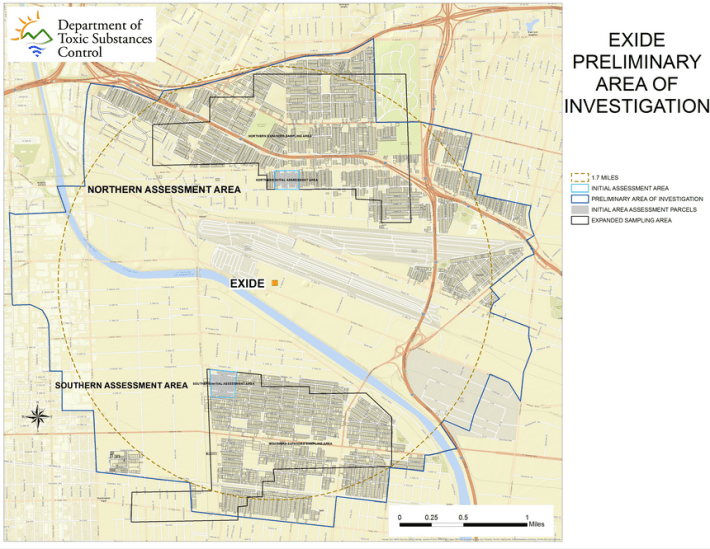
According to a press release, California Governor Jerry Brown just signed legislation directing $176.6 million "to expedite and expand [lead] testing and cleanup of residential properties, schools, daycare centers and parks around the former Exide Technologies facility in Vernon, California."
The legislation came in the form of A.B. 118, by Assemblymember Miguel Santiago (D-Los Angeles) and S.B. 93, by Senate President pro Tempore Kevin de León (D-Los Angeles) and Senator Ricardo Lara (D-Bell Gardens).
The funds -- a loan from the General Fund -- will allow the state to expedite soil testing within the 1.7-mile radius of the Exide Technologies facility and remediation of contaminated soil "where lead levels are the highest and potential exposure the greatest."
That last disclaimer suggests that $176.6 million may be enough to get the ball rolling on residential testing and cleanups, but not enough to finish the job.
Last fall, the Department of Toxic Substances Control was already running out of funds to continue testing and remediation, after spending just $8 million to put together a work plan and test and clean up fewer than 200 properties.
While the average cost of testing and cleaning up area properties -- originally estimated to be at about $40,000 per site -- may come down over time, the fact that as many as 10,000 may need remediation means the final bill may be more than double what was allotted today.
And it does indeed appear that most properties around the plant will need remediation, if current figures are anything to go by.
Of the 758 properties the Department for Toxic Substances Control (DTSC) has sampled thus far, only five have not needed cleanup. And, according to KPCC, of the 382 properties the County Department of Public Health (DPH) tested, 354 needed remediation, with 215 of them registering levels between the cleanup threshold of 80 parts per million (ppm) and 399 ppm of lead, and 139 having more dangerous levels hovering between 400 and 999 ppm.
The money also does not cover any of the costs borne by residents whose health was damaged by exposure to lead or other contaminants emitted by Exide over the decade-plus that it operated without a formal permit and regularly violated emissions standards. Nor, to the best of my understanding, will it cover the costs of any studies to investigate the longer-term health impacts on the surrounding communities.
But it is a good start. As is the governor's reiteration of a commitment to conduct a California Environmental Quality Act (CEQA) review of the cleanup process.
In disbursing these funds, the state is banking on Exide to reimburse them for the costs of the cleanup. The extent to which that will be possible remains to be seen. In its own study conducted last summer, Exide downplayed its responsibility for lead contamination in the areas surrounding the Vernon plant, declaring that, beyond the immediate footprint of the facility, “Exide’s estimated contributions to soil lead concentrations are no longer statistically distinguishable from [existing] background concentrations.”
In layman’s terms, that essentially translates to, “Good luck trying to hold us accountable.”
For more information on DTSC's testing and cleanup efforts in the communities near Exide, click here. For full text of the two bills signed today, visit http://leginfo.legislature.ca.gov/. Please keep an eye out for a longer-form story on Exide coming soon. In the meanwhile, see our extensive coverage on Exide’s confounding and often confusing case. More about the draft environmental impact report regarding Exide’s closure plan is here. More about the closure process, the lead testing process, and the challenge of linking Exide to the lead contamination can be found here. If you’d like to learn about why the community is adamant that state agencies be held accountable for allowing Exide to commit as many environmental crimes as it did, please see here, here, here, and here. If you’d like to know more about why the plant was shut down in the first place, please see here, here, here, here, here, and here.






